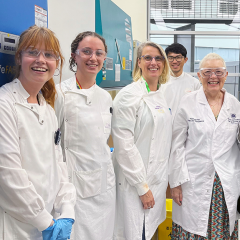A University of Queensland research discovery reveals how the body puts the brakes on inflammation, a discovery that will help us understand how poorly controlled inflammation exacerbates diseases including cystic fibrosis, Alzheimer’s, atherosclerosis and cancer.
Dr Lin Luo and Professor Jennifer Stow, from UQ’s Institute for Molecular Bioscience, led collaborative research that uncovered a previously unknown role for the cholesterol regulatory protein LRP1, showing that it also manages the body’s inflammation response.
Professor Stow said chronic inflammatory diseases occurred when inflammation could not be effectively switched off, leading to recurrent damage to organs such as the lungs.
“Inflammation is typically launched to ward off infection or danger, then subsequently curtailed to avoid ongoing tissue damage,” Professor Stow said.
“The inflammatory response is activated by Toll-like receptors, which are pathogen detectors on the surface of immune cells that serve as an alarm system for the body by recognising disease-causing or damaging molecules,” she said.
“We found that LRP1 is simultaneously activated and works in tandem with the pathogen detectors to ensure the inflammatory response is robust but self-limiting.
“LRP1 acts as a vital brake in this pathway, ensuring that inflammation does not go on to damage our own organs.”
Professor Stow said the discovery may have significant implications for the future treatment of chronic inflammatory diseases by enhancing our understanding of the growing link between cholesterol, metabolism, and inflammation.
“Together with Professor Peter Sly and his group at UQ’s Child Health Research Centre, and our collaborator in Chile, Dr Maria Marzolo, we are using this discovery to develop ways to manipulate inflammation which could help to limit organ damage in conditions like cystic fibrosis and other chronic diseases,” she said.
“While these interwoven systems are complicated, they are important to research and understand from a treatment perspective, offering both challenges and exciting potential for the cross-purposing of new and existing drugs.”
The study,published in Cell Reports, was supported by the National Health and Medical Research Council, the Australian Cancer Research Foundation and the Yulgilbar Foundation.



